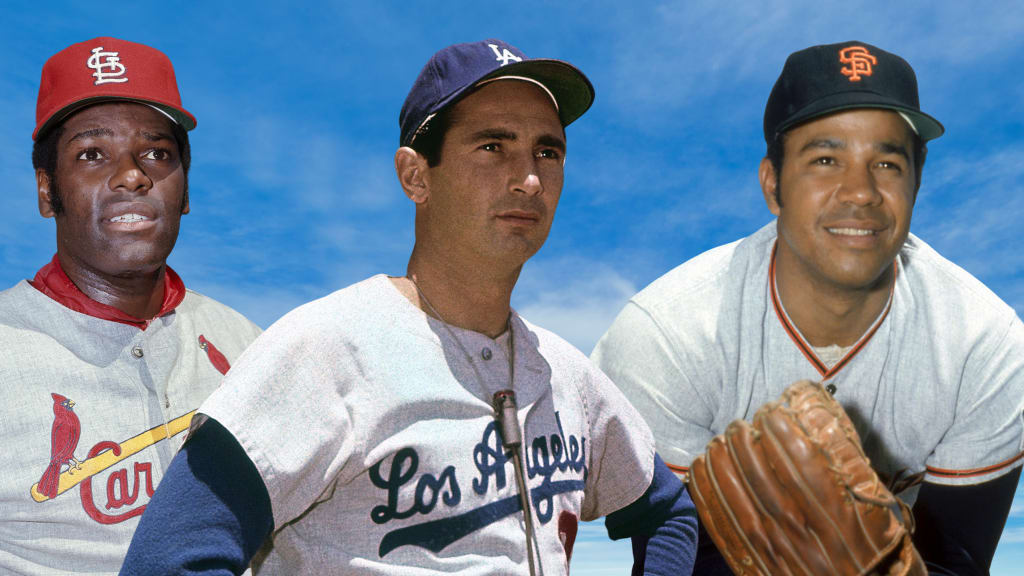
The idea was to pick an ace starting pitcher for each decade of the last 100 years in baseball, with one honorable mention. Some were relatively easy. For instance, Warren Spahn, perhaps the most underrated great pitcher of all time despite winning 363 games in the big leagues, wins the Fifties, with eight seasons of 20 wins or more, Robin Roberts the runner-up to him.
But then came the Sixties.
Going in, I thought it would be Sandy Koufax getting the edge over Bob Gibson, even though Koufax retired after the 1966 season. Except for this: If Spahn is underrated, so is Juan Marichal. This trinity of starters produced a body of work over one decade that I believe is comparable to anything we’ve ever seen, even with what Mr. Seaver and Mr. Palmer and Mr. Carlton did in the 1970s.
My feeling going in was that you really couldn’t have a baseball conversation like this without this conclusion: Koufax was the ace of the aces. But the more I looked at the numbers, the more it was clear that picking one out of these three was as hard as it must have been to hit against them.
Here is the reaction of Tim McCarver, who caught Gibson and had to face the other two starting with his first full season in Major League Baseball in 1964, when I asked Tim to pick the ace of the '60s:
“Not fair!”
Then he laughed and said, “Remember when Roy Campanella talked about how playing baseball made everybody feel like kids? Let me tell you something: not against those guys.”
Start with Koufax. He did not really begin the process of becoming the Koufax that baseball remembers until he won 18 games in 1961. And of course he pitched four no-hitters in the 1960s, including a perfect game against the Cubs that is the second-most-famous perfect game in history, not just because of Koufax’s luminous performance that night, but because of Vin Scully’s unforgettable radio call of the top of the ninth.
Then came the four seasons between 1963 and ’66 when I believe Koufax was the greatest pitcher who ever lived:
A record of 97-27, three seasons with an ERA under 2.00, three seasons of 300-plus strikeouts, three seasons of more than 40 starts, three seasons of 20 complete games or more and 27 complete games in each of his last two seasons -- both of which won him Cy Young Awards. He went 26-8 in 1965 and 27-9 in ’66. He struck out 382 batters in ’65. Here is his WHIP for those four seasons: 0.875, 0.928, 0.855, 0.985.
“When he’d get behind in the count,” McCarver said, “Sandy would challenge God.”
He pitched like a baseball god at the end of his career and then retired because of arthritis in his pitching elbow. It is why he “only” won 137 games in the 1960s, against 60 losses.
Then there is McCarver’s best friend, Gibson. Before you even get to his own glittering regular-season resume, it is always worth pointing out that Gibson pitched eight complete games out of nine starts in the World Series, with a record of 7-2. When I mentioned that to McCarver, he immediately said, “Lost his first one and his last one and nothing in between.”
Gibson, of course, had his own shining season in 1968, when his earned run average was 1.12, and his record was 22-9. On his way to that ERA, Gibson also recorded 28 complete games, including 13 shutouts. For the decade, he went 164-105 and, at his best, he was clearly the most intimidating of the trinity. McCarver laughed again when talking about that.
“It wasn’t that Bob was necessarily TRYING to hit you,” McCarver said. “He just didn’t care IF he hit you.”
Across the decade, Gibson had four 20-win seasons, a 19-win season and an 18-win season. Koufax, who was 4-3 in the World Series (and like Gibson lost his first WS start and his last), pulled off the rare double feat in 1963 of winning the Cy Young Award and the MVP Award. But Gibson did it as well in ’68.
Finally, there is Marichal, whose record for the decade was 191-88. Marichal won 20 or more games six times in the '60s. He won 18 another time. You know how many times he had 25 victories or more? Three! He never won a Cy Young Award. His only Fall Classic appearance was as a kid in the ’62 World Series, and he didn’t get back to the postseason until '71.
Marichal is possibly remembered more for the 1965 fight that ensued after he struck John Roseboro with a bat -- with Koufax pitching -- than for his most unforgettable start. On July 2, 1963, the most amazing pitching duel in history lasted 16 innings, with both Marichal and Spahn out there until the end. The Giants won 1-0 on a Willie Mays home run.
“As a pitcher, that’s Marichal’s mythological moment,” Bob Costas said. “Except there’s no footage of that game.”
Marichal threw 227 pitches at Candlestick Park that night; Spahn threw 201. But there is some mythology in something Marichal said that night: “[Spahn is] 42 and I’m 25, and you can’t take me out until that man is not pitching.”
In 1968, when Gibson had the season of his life, Marichal went 26-9 with an ERA of 2.43. In ’66, when Koufax was 27-9 with a 1.73 ERA, Marichal was 25-6 with a 2.23 ERA and 25 complete games. His timing was not so great.
“Perhaps the most interesting stat of all with Juan Marichal,” Costas said, “is that he had more complete games in his career [244] than victories [243].”
“If you were a Giant,” McCarver said, “you thought it was Marichal. If you were a Dodger, Koufax. And if you were a Cardinal, you thought it was Gibby.”
Three starters, one decade. No losers here. Baseball won.
